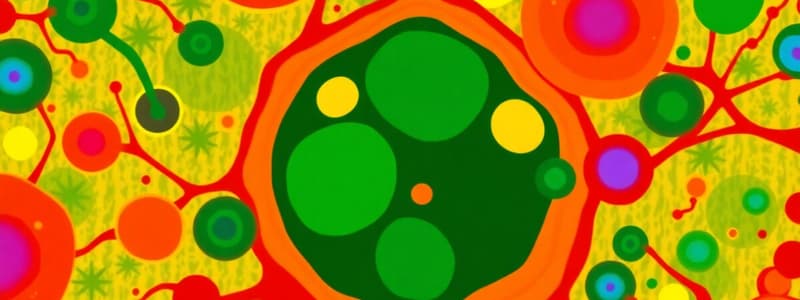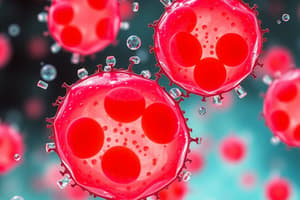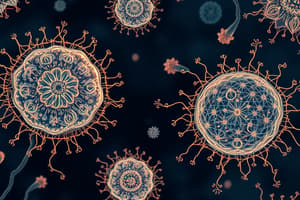Podcast
Questions and Answers
What is a key characteristic that differentiates prokaryotic cells from eukaryotic cells?
What is a key characteristic that differentiates prokaryotic cells from eukaryotic cells?
- Eukaryotic cells are structurally simpler than prokaryotic cells.
- Eukaryotic cells contain DNA free in the cytoplasm.
- Prokaryotic cells lack a nucleus. (correct)
- Prokaryotic cells have membrane-bound organelles.
Which of the following best describes compartmentalization in cells?
Which of the following best describes compartmentalization in cells?
- The arrangement of similar organelles into a single structure.
- The division of the cell into different spaces for independent reactions. (correct)
- The merging of cellular compartments to enhance metabolic efficiency.
- The process of endocytosis in prokaryotic cells.
What evidence supports the endosymbiont theory regarding mitochondria and chloroplasts?
What evidence supports the endosymbiont theory regarding mitochondria and chloroplasts?
- They are identical to the DNA found in the cell nucleus.
- They reproduce through binary fission similar to prokaryotes. (correct)
- They have a single layer of membrane surrounding them.
- They are not present in eukaryotic cells.
Which statement is true regarding eukaryotic cells?
Which statement is true regarding eukaryotic cells?
Which of the following is NOT considered a feature of prokaryotic cells?
Which of the following is NOT considered a feature of prokaryotic cells?
What is the significance of compartmentalization in eukaryotic cells?
What is the significance of compartmentalization in eukaryotic cells?
What feature is unique to eukaryotic cells compared to prokaryotic cells?
What feature is unique to eukaryotic cells compared to prokaryotic cells?
What does the endosymbiont theory suggest about the origins of mitochondria and chloroplasts?
What does the endosymbiont theory suggest about the origins of mitochondria and chloroplasts?
Which statement accurately reflects a characteristic of prokaryotic cells?
Which statement accurately reflects a characteristic of prokaryotic cells?
Why do mitochondria and chloroplasts have their own DNA?
Why do mitochondria and chloroplasts have their own DNA?
Flashcards
Eukaryotic Cell
Eukaryotic Cell
A cell with a nucleus and membrane-bound organelles.
Prokaryotic Cell
Prokaryotic Cell
A cell without a nucleus or membrane-bound organelles.
Compartmentalization
Compartmentalization
Division of a cell into compartments with distinct functions.
Endosymbiont theory
Endosymbiont theory
Signup and view all the flashcards
Evidence for Endosymbiosis
Evidence for Endosymbiosis
Signup and view all the flashcards
What's the key difference between prokaryotic and eukaryotic cells?
What's the key difference between prokaryotic and eukaryotic cells?
Signup and view all the flashcards
What is compartmentalization in a cell?
What is compartmentalization in a cell?
Signup and view all the flashcards
What does the endosymbiont theory explain?
What does the endosymbiont theory explain?
Signup and view all the flashcards
Mitochondria and chloroplasts
Mitochondria and chloroplasts
Signup and view all the flashcards
Double membrane structure
Double membrane structure
Signup and view all the flashcards
Study Notes
Cell Structure
- Animal and plant cells are eukaryotes, possessing a nucleus and numerous organelles (e.g., mitochondria, chloroplasts, endoplasmic reticulum)
- Bacteria are prokaryotes, lacking a nucleus
- Key differences between eukaryotes and prokaryotes: eukaryotes have a nucleus and membrane-bound organelles, while prokaryotes lack a nucleus and have free DNA in their cytoplasm. Their structure is simpler.
Cell Compartmentalization
- Compartmentalization divides the cell into compartments, enclosed by membranes. These allow different chemical reactions to occur simultaneously and independently within those areas.
- Examples of these compartments include the nucleus, endoplasmic reticulum, and Golgi apparatus
Endosymbiotic Theory
- This theory explains how eukaryotes evolved from prokaryotes.
- It suggests that primitive eukaryotic cells engulfed free-living bacteria, which were not digested, but rather, formed a symbiotic relationship with the host cell.
- Evidence of this theory is that mitochondria and chloroplasts possess their own DNA and ribosomes. They also reproduce through binary fission, similar to bacteria.
- The presence of a double membrane suggests the history of endocytosis.
Studying That Suits You
Use AI to generate personalized quizzes and flashcards to suit your learning preferences.




